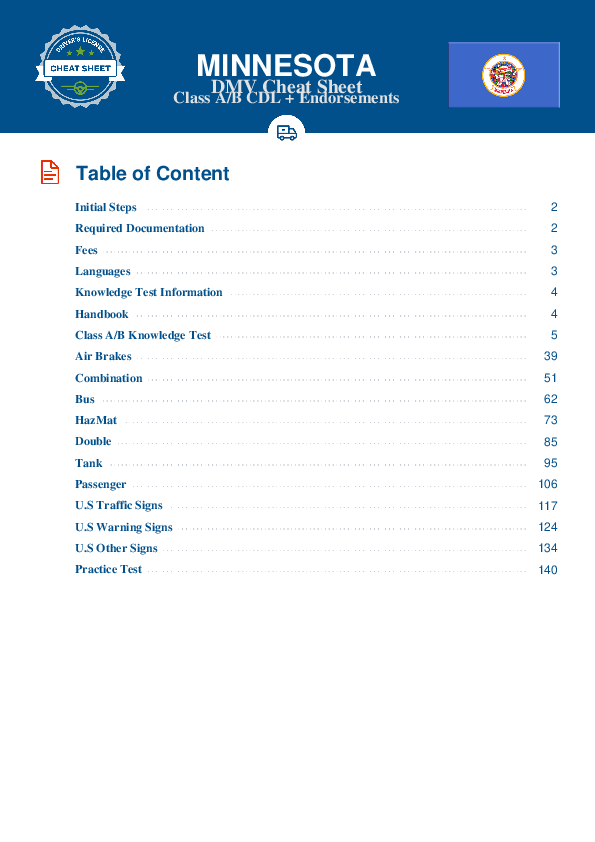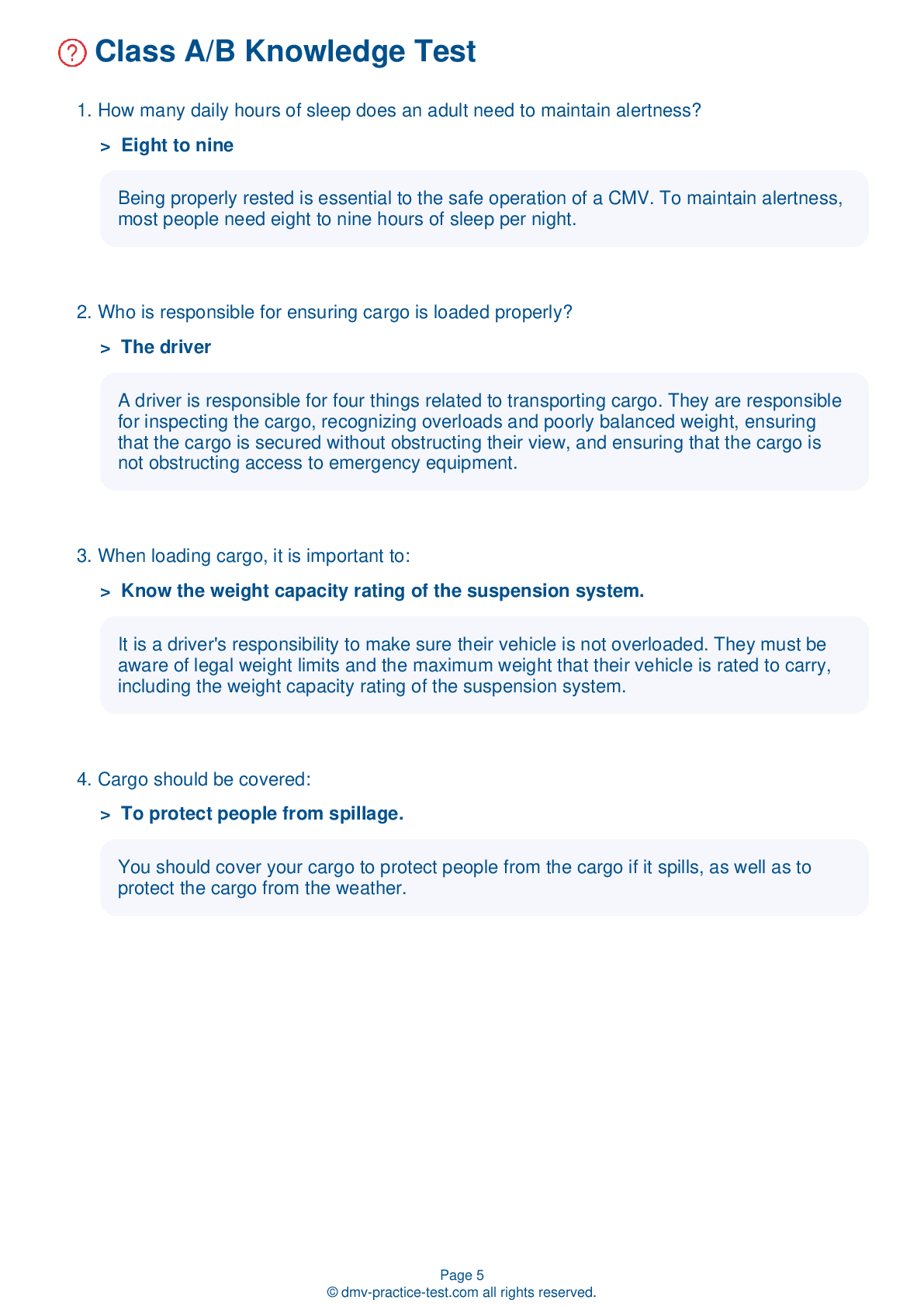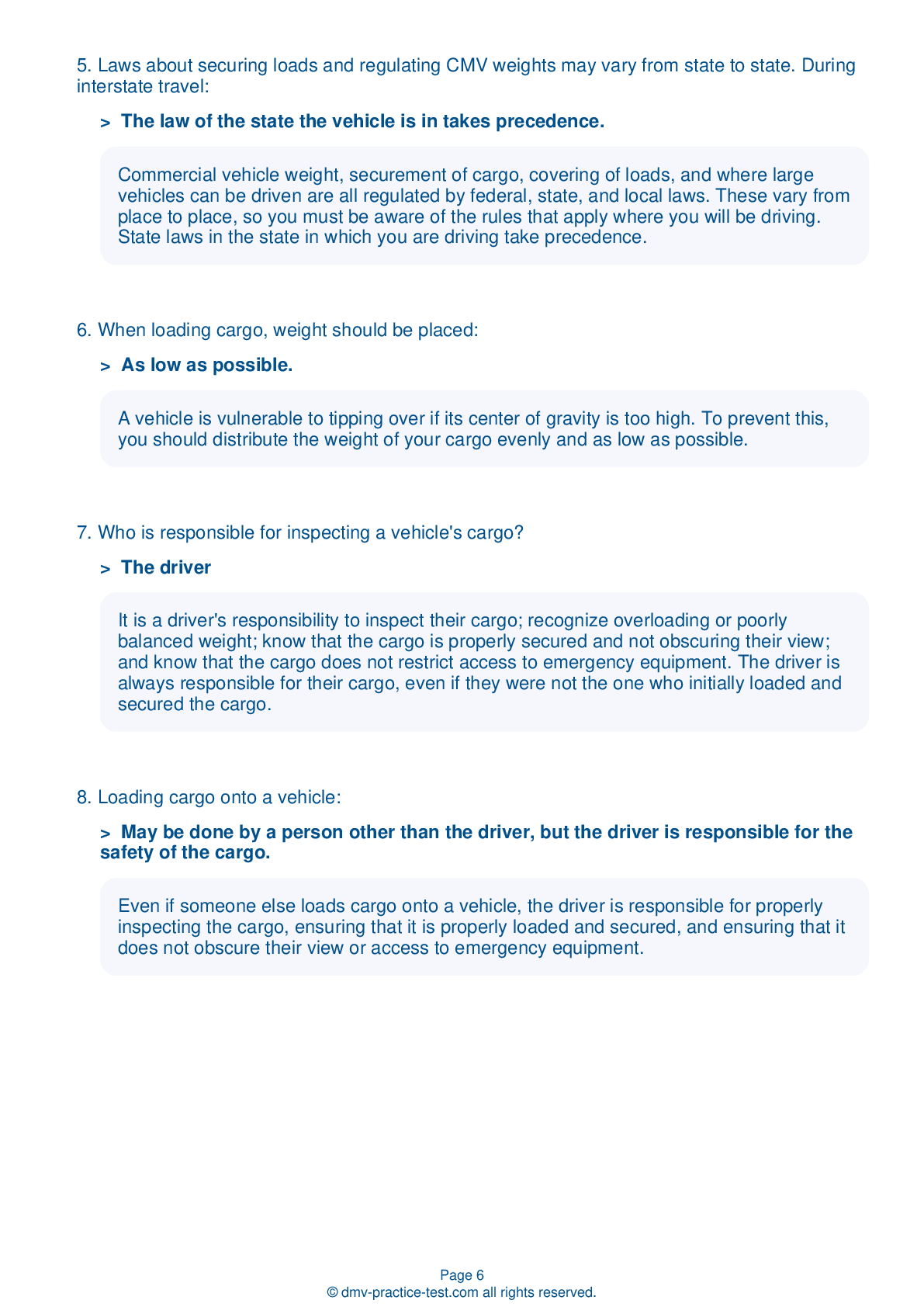Passenger #1
Passenger Endorsement | Minnesota 2025 #1 Page 2 of 3
Train for FREE with our Minnesota CDL passenger endorsement practice test online. The official exam test consists of several obligatory parts, with all of them checking your knowledge of different blocks of road rules. If you need to obtain a MN DMV passenger endorsement in 2025, practice as much as possible. Free sample tests published on our website will help you check and improve your knowledge and boost your grades. Please bear in mind that DMV requirements for issuing a CDL permit with passenger endorsement may vary from state to state.
20
16
20
8 . Water should be added to the compressed air in an air brake system to improve the effectiveness of the system.
Compressed air in an air brake system usually contains a certain amount of water and compressor oil. The water and oil can damage the brakes if left to accumulate in the system. Tanks must be drained regularly to remove this build-up.
9 . An alcohol evaporator removes alcohol from the air brake system.
Some air brake systems contain an alcohol evaporator. This device introduces alcohol into the braking system to inhibit the formation of ice.
10 . Gross Vehicle Weight Rating (GVWR) is how much weight can be supported by a vehicle's tires.
A Gross Vehicle Weight Rating (GVWR) is the value specified by the manufacturer as the loaded weight of a single vehicle.
11 . While passengers are on board a bus, refueling the bus in an enclosed space, allowing the bus to be towed, and conversing with the passengers are considered to be:
Bus drivers should not engage in conversation with passengers, fuel a bus inside an enclosed building, or tow or push a disabled bus with riders aboard the vehicle. These are all considered to be prohibited practices.
12 . A truck should be driven over a truck apron in a roundabout.
Truck aprons are often included on single-lane entries to roundabouts to allow for the off-tracking of turning trucks. A truck apron can also allow oversized and/or overweight vehicles to more easily navigate the intersection.
13 . Small arms ammunition should never be carried in the passenger compartment of a bus.
It is permissible for buses to carry small arms ammunition in the passenger compartment of the vehicle if the ammunition is labeled ORM-D.
14 . When driving a vehicle, knowing what is happening behind you is:
It is important to be constantly aware of what is going on behind and to the sides of your vehicle. You will only be able to react to hazards if you know where and what they are.
2025 Minnesota | Frequently Asked Questions
A CDL Class A license in Minnesota is defined as a commercial driver's license that allows the holder to operate any combination of vehicles with a Gross Vehicle Weight Rating (GVWR) of 26,001 pounds or more, provided the towed vehicle is heavier than 10,000 pounds. It typically covers vehicles like tractor-trailers, truck and trailer combinations, and tank vehicles.
A Class A CDL license in Minnesota allows the holder to operate several types of heavy vehicles. These include tractor-trailers, truck and trailer combinations, tank vehicles, and livestock carriers. The license permits driving any combination of vehicles with a Gross Vehicle Weight Rating (GVWR) of 26,001 or more pounds, provided the towed vehicle exceeds 10,000 pounds.
To obtain a Class A CDL license in Minnesota, one must be at least 18 years old (21 for interstate travel), possess a valid Minnesota driver's license, pass a vision test, and successfully complete a general knowledge test. Additionally, applicants must pass skills tests in the vehicle type that the driver expects to operate. Medical examinations are also typically required.
In Minnesota, you must be at least 18 years old to apply for a Class A CDL for intrastate transport (within Minnesota only). However, federal regulations require drivers to be at least 21 years old to drive commercial vehicles across state lines (interstate transport) or to transport hazardous materials.
While not necessarily required, specific endorsements on a Class A CDL license can expand the types of vehicles you're allowed to drive and the cargo you can carry. These include T for Double/Triple Trailers, P for Passenger Vehicles, N for Tank Vehicles, H for Hazardous Materials, and S for School Buses. Each endorsement requires passing additional tests.
The Class A CDL skills test in Minnesota comprises three parts: pre-trip inspection, basic vehicle control, and on-road driving. The pre-trip inspection checks your ability to assess the condition of your vehicle. Basic vehicle control tests your skills in controlling the vehicle, and on-road driving evaluates your ability to drive safely in various road conditions.
Yes, limitations can be imposed on Class A CDL license holders in Minnesota. These are known as restrictions, and they limit the type of vehicle you can operate or require you to use certain equipment. Examples include 'E' for no manual transmission, 'K' for intrastate only, 'L' for no air brake equipped CMV, 'M' and 'N' for class of vehicle restrictions, and 'O' for no tractor-trailer CMV.
Yes, in Minnesota, the written Class A CDL test can be taken in several languages besides English. These include Spanish, Hmong, Vietnamese, Russian, and Somali. However, the state requires that all CDL holders be able to read and speak English well enough to converse with the general public, understand highway traffic signs and signals, respond to official inquiries, and make entries on reports and records.
Yes, Minnesota allows accommodations for the Class A CDL written test for individuals with disabilities. You need to make this request in advance when scheduling your test. Accommodations can include more time to take the test, a separate room, or having the test read aloud. However, all requests are subject to approval and must comply with federal regulations.
Yes, if you don't pass the Class A CDL written test in Minnesota, you can retake it. However, you must wait until the next day to do so. The state allows multiple attempts, but each retest requires a new fee. Remember to study thoroughly using the Minnesota Commercial Driver’s Manual before retaking the test.



